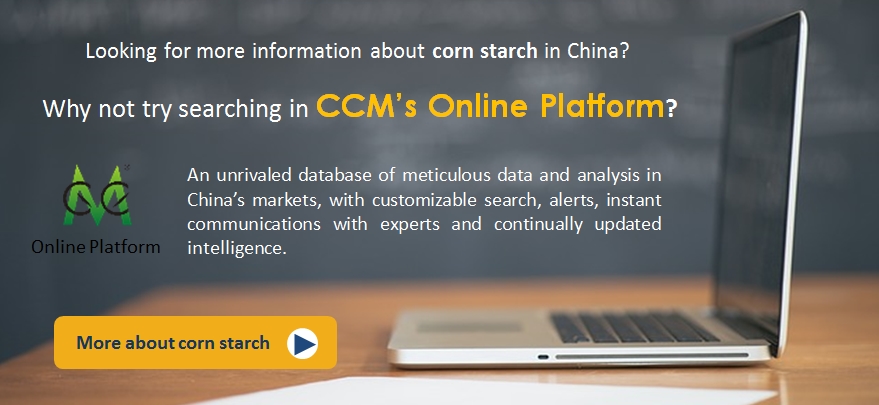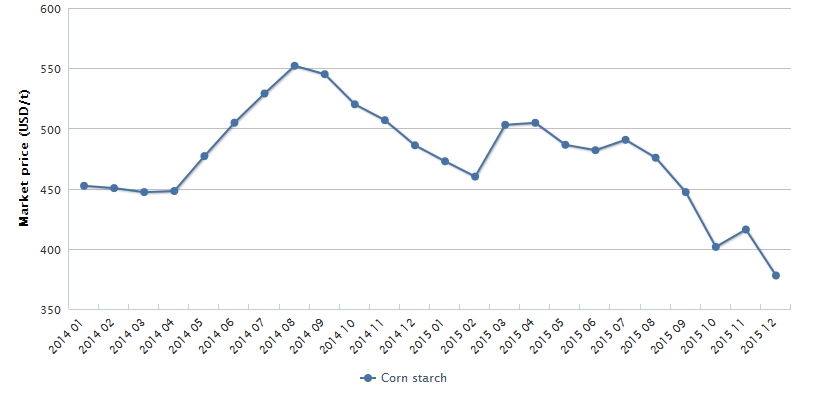Affected by the rising operating rates due to the coming end of processing
subsidy policy of corn and the declining price of raw materials, China's market price of corn starch slides down once again. It is predicted that the space for
corn starch demand to grow will be limited under the influences of the growing
number of competing products, the arrival of the slack sales season and the
passive export.
In Dec. 2015, China's market price of corn starch was back to a downturn after
a small rebound in Nov. 2015, and the decline was quite significant after
mid-to-late Dec. According to CCM research, on 15 Dec., 2015, the average
market price of corn starch in northern China was USD390.79/t (RMB2,500/t). But
by 25 Dec., the price has declined to USD359.53/t (RMB2,300/t), down by 8.00%
in just ten days. On a whole, the average price in Dec. was USD377.82/t
(RMB2,417/t), down 22.26% from the same period of 2014.
Actually, there are two blocks keeping the market price of corn starch from
recovery.
1. The subsidy policy on corn processing
comes to an end.
Jilin Province, one of China's major producers for corn starch no more
enjoyed the subsidy policy on deep processing after the day of 31 Dec. In order
to catch the last chance to enjoy the subsidy, many deep-processing enterprises
substantially improved their operating rates. In Dec. 2015, the operating rate
of deep-processing enterprises in Jilin was over 80%. The enhanced market
supply drove the price down.
Although industry insiders generally believed that there was great possibility
for Heilongjiang Province and Jilin to continue the
deep-processing subsidies in the general policy orientation to accelerate the
consumption of the corn inventory in 2016, manufacturers generally chose to
step up their production to fill up the inventory before the detailed amount
and the exact time of subsidy were officially released.

2. The market price of corn starch is
led by the price trend of raw materials.
The cost prediction is based on the average prices of related products in Dec.
2015.
The cost in producing
one tonne of corn starch = 1.4 tonnes of corn (USD297.01/t
- RMB1,900/t) + processing charges (USD85.97/t - RMB550/t) - the profits from
by-products (0.09 tonne of corn gulten meal that is priced at
USD604.94/t - RMB3,870/t, 0.04 tonne of corn oil that is priced at
USD1,485.00/t - RMB9,500/t and 0.35 tonne of corn germ meal that is priced
at USD125.05/t - RMB800/t).
In Dec., the average production cost of corn starch was USD344.16/t
(RMB2,201.70/t). When the profits from by-products haven't been considered, the
cost of corn is more than 85% related to the cost of corn starch.
As the weather got better and the supply of corn recovered to the normal level
in Dec., the corn price started to fall down again under the huge inventory
pressure. According to the data collected by CCM, China's market price of
corn in Dec. was USD297.01/t (RMB1,900/t), down 2.82% month on month.
Therefore, the corn starch price was dragged down by the raw material price.
As the price kept falling, the corn starch started to squeeze the market space
of other starch products, but it is predicted that the space for corn starch
demand to grow is limited.
The number of competing products is
boosted.
As Vietnam and Thailand, China's two major cassava starch import origins are
busy in production from Nov. to Jan. of the following year, which will enhance
China's import volume of cassava starch with dropping import price. It is forecasted
that the import volume in later period will keep growing. According to China
Customs, China imported 124,200 tonnes of cassava starch in Nov.
2015, up 25.20% month on month and the import price was USD421.00/t, down 4.97%
month on month.
The slack sales season is arriving.
After the Spring Festival, China will encounter the slack sales seasons of
starches, thus downstream manufacturers for food and starch sugar will not call
for too much inventory and purchases. Besides, when the subsidy policy is due,
the production cost of corn starch will go up and probably its sales price will
climb up, which is not good for the sales.
The export is passive.
The export tax rebate policy on corn starch (export rebate rate: 13%) ran out
in 2016. China's competitiveness of corn starch in the international market
will weaken. Meanwhile, on 19 Dec., 2015, an agreement about the policy on
agricultural export competition was achieved at the Ministerial Conference of
the World Trade Organization just concluded in Nairobi, capital of Kenya - both
developed and developing countries will completely cancel the export subsidies
for agricultural produces.
These two policies will be unfavorably help China to export its corn
starch.
Average market price of corn starch in
northern China, Jan. 2014-Dec. 2015

Source: CCM

About CCM:
CCM is the leading market intelligence provider for China's agriculture, chemicals, food & ingredients and life science markets. Founded in 2001, CCM offers a range of data and content solutions, from price and trade data to industry newsletters and customized market research reports. Our clients include Monsanto, DuPont, Shell, Bayer, and Syngenta.
We will attend FIC in this week. If you would like to meet us for consultancy in FIC, please get in touch with us directly by emailing econtact@cnchemicals.com or calling +86-20-37616606.